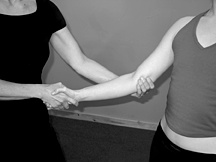Pronator Teres Syndrome Test
Original Editor - Anquain Sullivan
Top Contributors - Anquain Sullivan, Kim Jackson, Admin, Hunter Hansen, Rachael Lowe, Vidya Acharya, WikiSysop, Claire Knott, Cindy John-Chu, Erick Perea, Jacob Bowman, Wanda van Niekerk and Olajumoke Ogunleye
Edited April 2022 - by Hunter Hansen as part of the Arkansas Colleges of Health Education School of Physical Therapy Musculoskeletal 1 ProjectIntroduction[edit | edit source]
Pronator Teres Syndrome (PTS) is a compression neuropathy of the median nerve at the elbow. It is not as common as compression at the wrist which is Carpal Tunnel Syndrome (CTS). PTS and CTS present similarly, however PTS can be distinguished by a lack of sensation in the distribution of the palmar cutaneous branch of the median nerve (PCBMN) and the absence of common CTS test findings. The PCBMN branches off of the median nerve proximally to the carpal tunnel. Because of its site of origin, this nerve can be affected by median nerve entrapment of the forearm (such as in PTS), but will not be affected by entrapment in the carpal tunnel.
It should also be noted that Anterior Interosseous Nerve Syndrome (AIN Syndrome) is another disorder that can occur with anatomical compression at the elbow, similar to PTS. However, AIN Syndrome presents strictly as a motor palsy of some or all of the muscles innervated by the median nerve in the forearm, including flexor digitorum profundus of the index and middle fingers, flexor pollicis longus and pronator quadratus.
Purpose[edit | edit source]
The purpose of this test is to help differentiate between Pronator Teres Syndrome and Carpal Tunnel Syndrome.
Clinical Signs[edit | edit source]
Compression of the median nerve at the elbow can lead to pain and/or numbness in the distribution of the distal median nerve and weakness can develop in the flexor pollicis longus and flexor digitorum profundus of the index finger and the pronator quadratus.
The physical findings of this would be tenderness over the pronator teres muscle and pain with resisted pronation of the forearm. Weakness could be present with abduction of the thumb as well as impairment to the pincer muscles. Sensation changes may also be experienced in the first three fingers and the palm.
Technique[edit | edit source]
The patient stands with the elbow in 90 degrees of flexion. The clinician then places one hand on the client's elbow for stabilization and the other hand grasps the patient's hand in a handshake position. The patient maintains their forearm in a neutral position while the therapist attempts to supinate the patient's forearm, requiring the patient to actively resist this movement by engaging their pronator muscles (as they try to move into pronation). While holding the resistance against pronation, the clinician extends the patient's elbow. If the patient's pain or discomfort is reproduced, there is a good chance of median nerve compression by the pronator teres. The patient should keep the elbow relaxed during the test, because holding the elbow firmly in flexion will not allow elbow extension.
Evidence[edit | edit source]
There are three main maneuvers that are performed in order to evaluate for Pronator Teres Syndrome (PTS). These maneuvers are the pronator compression test, resisted pronation/supination and resisted flexion of the proximal interphalangeal joint (IPJ) of the 3rd digit. The pronator compression test is positive when pain or paresthesia is reproduced after applying 30 seconds of pressure proximally and laterally to the proximal edge of the pronator teres muscle belly. According to Rodner, Tinsley and O’Malley, a positive pronator compression test is “the most common sign of pronator teres syndrome.[1]” Resisted pronation and supination (described above in the Technique section), are tested to determine if the symptoms of PTS are reproduced. Finally, resisted flexion of the proximal IPJ of the 3rd digit may reproduce pain and paresthesia in patients with PTS due to the median nerve entrapment at the heads of the flexor digitorum superficialis.
In order to substantiate the use of these examination findings, additional studies should be considered to establish diagnostic values such as sensitivity and specificity.
References[edit | edit source]
- ↑ Rodner CM, Tinsley BA, O’Malley MP. Pronator syndrome and anterior interosseous nerve syndrome. The Journal of the American Academy of Orthopaedic Surgeons [Internet]. 2013 May [cited 2022 Apr 12];21(5):268–75. Available from: https://search.ebscohost.com/login.aspx?direct=true&db=mdc&AN=23637145&site=eds-live
- Rodner CM, Tinsley BA, O’Malley MP. Pronator syndrome and anterior interosseous nerve syndrome. The Journal of the American Academy of Orthopaedic Surgeons [Internet]. 2013 May [cited 2022 Apr 12];21(5):268–75. Available from: https://search.ebscohost.com/login.aspx?direct=true&db=mdc&AN=23637145&site=eds-live
- Hartz, C R, R L Linscheid, R R Gramse, and J R Daube. “The pronator teres syndrome: compressive neuropathy of the median nerve.” The Journal of Bone and Joint Surgery. American Volume 63, no. 6 (July 1981): 885-90
- Morris, H H, and B H Peters. “Pronator syndrome: clinical and electrophysiological features in seven cases.” Journal of Neurology, Neurosurgery, and Psychiatry 39, no. 5 (May 1976): 461-4.
- Wertsch, J J, and J Melvin. “Median nerve anatomy and entrapment syndromes: a review.” Archives of Physical Medicine and Rehabilitation 63, no. 12 (December 1982): 623-7.
- Bridgeman, C, S Naidu, and M J Kothari. “Clinical and electrophysiological presentation of pronator syndrome.” Electromyography and Clinical Neurophysiology 47, no. 2: 89-92.1.
- Lowe, W. "Pronator Teres Syndrome." Massage Today 7, no 5 (May 2007).







